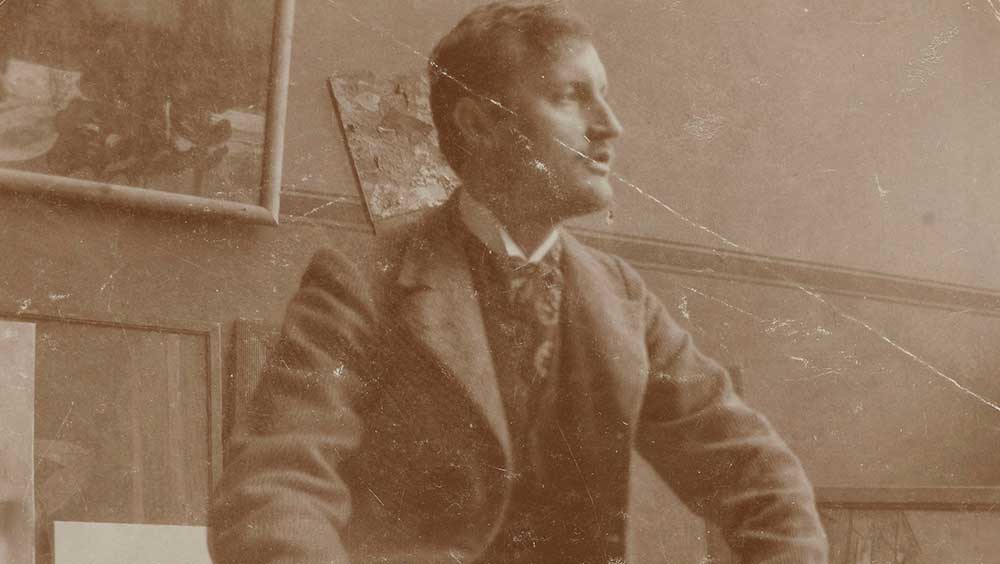
Edvard Munch, Self-Portrait on a Valise in the Studio, 1902 (detail). Photo © Munch, Oslo.
Magic of the North, Berlinische Galerie, Berlin
15 September 2023 – 22 January 2024
and
Trembling Earth, Museum Barberini, Potsdam
18 November 2023 – 1 April 2024
by SABINE SCHERECK
The Berlinische Galerie, dedicated to art in Berlin, revisits Edvard Munch’s time in the city, which was a defining period in his career and set Berlin’s art scene on the path of modernity. Edvard Munch: Magic of the North traces the relationship between the artist and the city, which began with a scandal in 1892.
For Berliners at the start of the 20th century, the north was a mystical place. The Kaiser regularly travelled to Scandinavia and the ocean liner Auguste Victoria sailed to Norway on her maiden voyage. The ship is depicted amidst the majestic mountains lining a fjord in The Auguste Victoria in Naeröfjord (1900) by the German painter Themistokles von Eckenbrecher. This impressive work is shown at the beginning of the exhibition and inspires city dwellers to dream of the north. The same applies to Summer Evening in the Lofoten (before 1891) by his Norwegian colleague Adelsteen Normann, who had settled in Berlin.
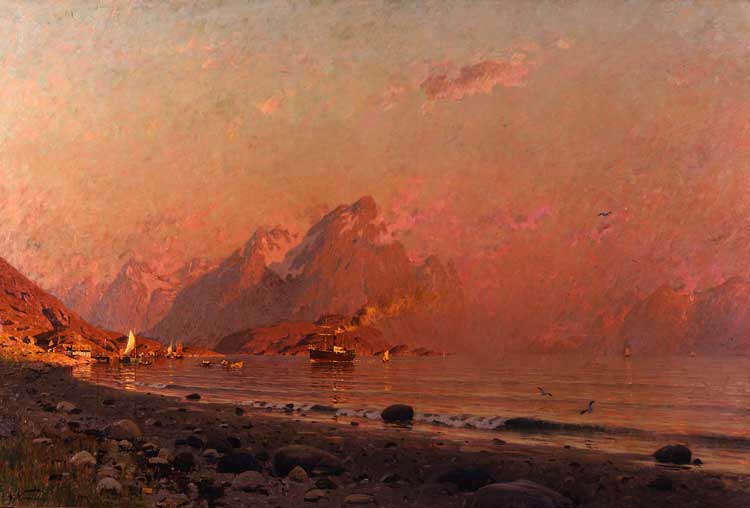
Eilert Adelsteen Normann, Summer Evening in the Lofoten, before 1891. Photo © Staatliche Museen zu Berlin, Nationalgalerie / Andres Klinger.
After Normann persuaded the Verein Berliner Künstler (Association of Berlin Artists) to invite Munch (1863–1944), his largely unknown fellow countryman, to hold a solo exhibition in the city, the show’s opening in 1892 was keenly anticipated. Yet, shocked by what was presented to it, seemingly rough and unfinished works far from any Nordic visions of beauty, the Verein closed the exhibition after just a few days. News of this scandal, known as the Munch Affair, spread like wildfire, making others wonder what this bad boy of art had conjured up and inviting him themselves to find out. Amused by this scandal, the 28-year-old Munch moved to Berlin, where, with a few interruptions, he continued to live and work until 1908.
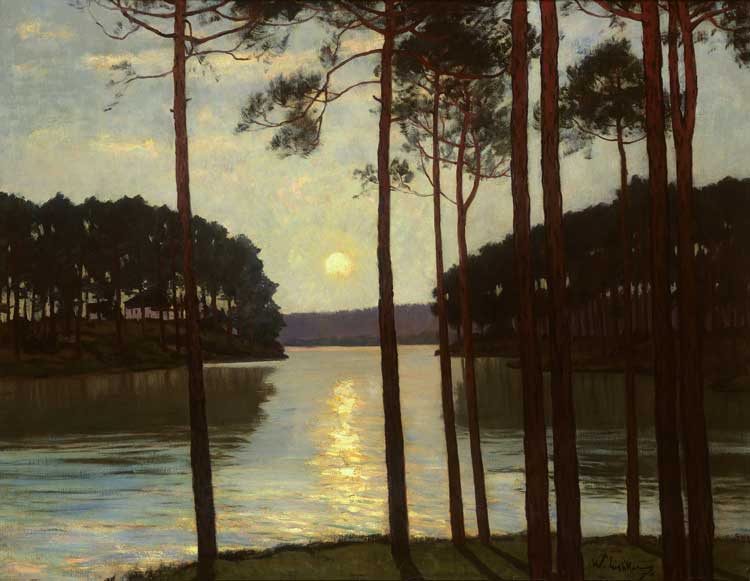
Walter Leistikow, Evening over Schlachtensee, c1895. © Collection Stiftung Stadtmuseum Berlin, Photo: Hans-Joachim Bartsch, Berlin.
The Berlinische Galerie cleverly leads into the show by juxtaposing Munch’s revolutionary way of seeing the world with the style of images the Berlin audience was familiar with at the time. This includes Normann’s Summer Evening in the Lofoten as well as, poignantly, Walter Leistikow’s Fjord Landscape (c1897) and Evening Over Schlachtensee (c1895). Both have a pleasant and conventional feel, despite the fact that Leistikow belonged to Berlin’s progressive artists’ collective Vereinigung der XI (Federation of the XI), founded in February 1892, before Munch shook up the city’s art scene in November that year. It is no surprise that Munch’s supporters came out of these ranks. With this group evolving into the Berlin secession movement and artistically leading the way from 1898 onwards, Munch became an accepted artist. By 1933, the city had hosted 60 exhibitions of his work.
The Munch paintings placed amid Leistikow’s are Starry Night (1922-24) and Winter Night (c1900), from which emanate a sense of Magic of the North – Munch-style. However, little of that is left in the following rooms, as the visualisation of emotions through human figures take over – they are one of Munch’s trademarks.
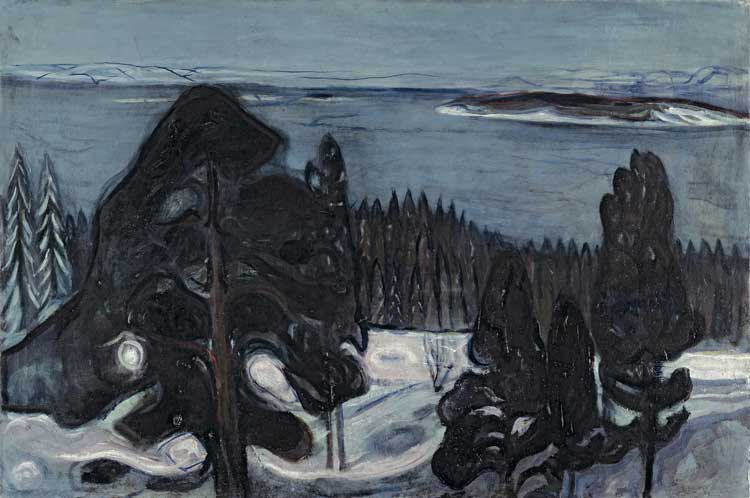
Edvard Munch, Winter Night, c1900. Photo © Kunsthaus Zürich.
Parts of The Frieze of Life, a series of paintings portraying the cycle of life including love, anxiety and death, stretch out along the wall of the large hall. It was in Berlin where he began experimenting with presenting pictures in a series and the first kernel of this frieze, Studies for a Series: Love, was shown in December 1893. Munch continued working on this project throughout his life, exchanging components of it over the years.
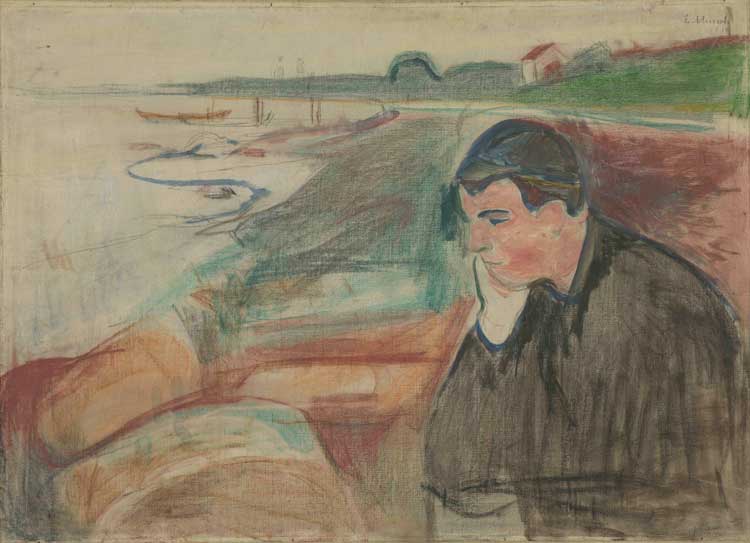
Edvard Munch, Melancholy (Evening), 1891, Photo: © Munchmuseet / Halvor Bjørngård.
The ones presented here date from 1891 to 1935. Among them are Melancholy (Evening) (1891), which also featured in his Berlin debut, and The Kiss (1897). The latter is rendered in very dark tones. As if it were night, only the outlines of an embracing couple can be made out in front of a curtain by a window. Munch’s Melancholy, following the sad ending of a love affair, shows a man in a pensive mood by the shore. It is overall much brighter, suggesting that the kiss shrouded by the secrecy of darkness is the beginning of a downfall. But figures in a sombre or serious mood are a common sight at this exhibition, provided their faces have any detail at all. This counterpoint of dark themes with light colours, or vice versa, is also evident in Death and Spring (1893), in which a woman in a lilac-coloured dress lies in front of a window looking on to a bright green meadow in the sunshine. With nature coming back to life, the picture reminds the viewer that not only life overall continues after an individual death, but also that death is a part of the life cycle.
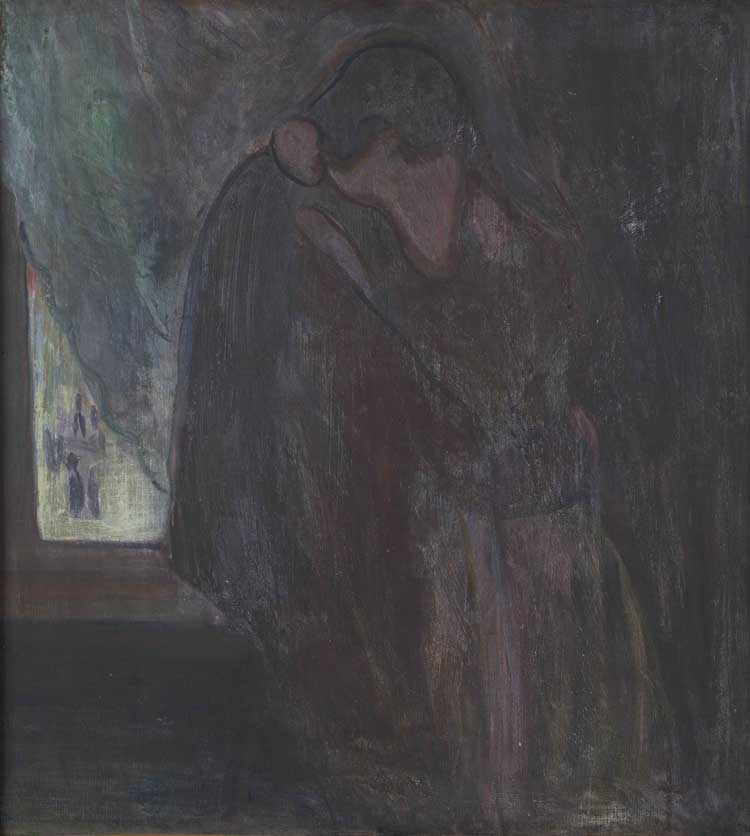
Edvard Munch, The Kiss, 1897. Photo: © Munch, Oslo / Halvor Bjørngård.
With regard to Munch’s penchant for friezes, the exhibition also shows parts of the Linde Frieze, commissioned by the art collector Max Linde to decorate his children’s nursery. However, its colours were too strong and, worse still, the depiction of a kissing couple wasn’t deemed appropriate for its purpose, so Linde rejected it. In 1906, the theatre director and impresario Max Reinhardt was also keen to have a frieze by Munch for his theatre. Munch produced one, but when the theatre was refurbished in 1912, Munch’s work was sold. So, it is quite a coup to be able to see parts of it here, but at the same time there is a sense of disappointment. The images do not bear any signs that they were made for a theatre. Instead, they pick up themes and scenes that Munch had captured on canvas before, such as the kiss, melancholy or desire. All the scenes are set outdoors and are on the brighter side of the colour spectrum. One wonders about Munch’s choice of motifs considering he moved in Berlin’s bohemian circle along with the Swedish dramatist August Strindberg and other Scandinavian artists who had made Berlin their home.
The later sections of this exhibition, which was curated by Stefanie Heckmann from the Berlinische Galerie, present portraits and prints as Munch discovered graphics and print-making for himself in Berlin in 1894. More intriguing is a collection of small sepia photographs, among them self-portraits in his studio and documentations of his exhibitions. He had taken up photography in 1906 and these photos offer a fascinating insight into his everyday life in the city.
The final room sketches the complicated relationship between himself and Germany after the Nazis had come to power in 1933. First, he was celebrated as a “Nordic-Germanic” painter, but then dismissed as a “degenerate” artist and his works were removed from German museums. While some pictures were returned after the war, Snow Shovellers (1913-14) was destroyed and a black-and-white photographic reproduction here marks the loss.
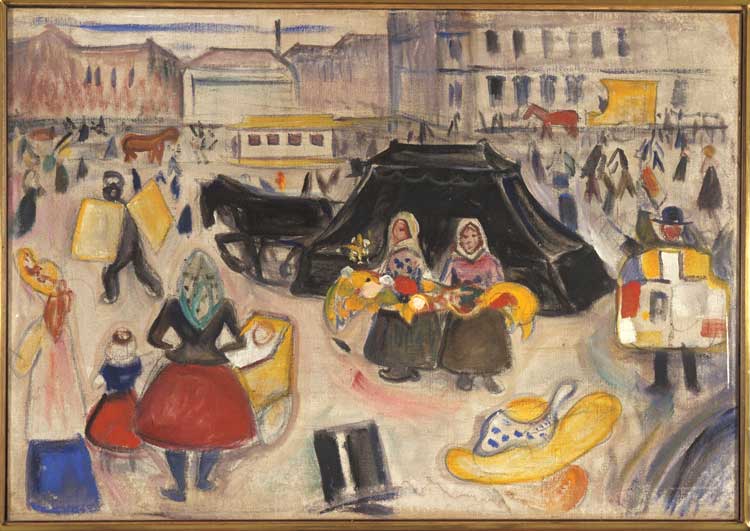
Edvard Munch, The Hearse on Potsdamer Platz, 1902. Photo: © Munch, Oslo / Sidsel de Jong
Walking through the exhibition, which comprises about 80 works by Munch, there is little evidence in the pictures that Munch was in Berlin, except for The Hearse on Potsdamer Platz (1902). The themes explored could be set anywhere, suggesting that Munch was so preoccupied with what moved him emotionally, that he didn’t take in his surroundings, although, of course, Berlin offered an increasingly liberal atmosphere, in which he could pursue his expressionistic art. Yet, in order to understand his interaction with the city and the artistic impulses he received, the accompanying texts within the exhibition are vital.
The second show to honour the artist this autumn is the forthcoming Edvard Munch: Trembling Earth, at the Museum Barberini, which will invite visitors to join Munch on his forays into nature. This exhibition is currently at the Clark Art Institute in Williamstown in the US and the joint catalogue gives an insight into what can be expected when it comes to Potsdam. In eight sections, the exhibition will take the visitor to the forest, the shore and Munch’s chosen places, as well as focusing on how humans interact with nature when cultivating the landscape and how storm and snow transform it.
While the exhibition at the Berlinische Galerie can be regarded as an introduction to Munch, outlining what characterises his work, the exhibition at the Museum Baberini moves one step further: first, in a way, it picks up a decisive period after Berlin, that is from 1909 to 1915, when Munch settled back in Norway in the coastal town of Kragerø and engaged with nature more intensely; and second, his depictions of nature have previously been largely neglected by the art world even though they form a major part of Munch’s oeuvre as this show demonstrates. With about 110 works, this is the first exhibition focusing on his landscape paintings.
The images range in style and mood. There are Rugged Trunks (1928-30) and Elm Forest in Autumn (1919-20) with rather fast and nervous brushstrokes on the one side and there is Dark Spruce Forest (1899), on the other, which is dominated by shapes. Moreover, the last stands out because of its vibrant dark-blue sky, muted green fir trees and its calming effect on the viewer. It is not a picture that would be instantly attributed to Munch. The same applies to Cabbage Field (1915). Although a seemingly unspectacular subject, the luminous green-bluish colour of the cabbages, parts of a yellow field and the bright slip of light at the horizon give it a cheerful air.
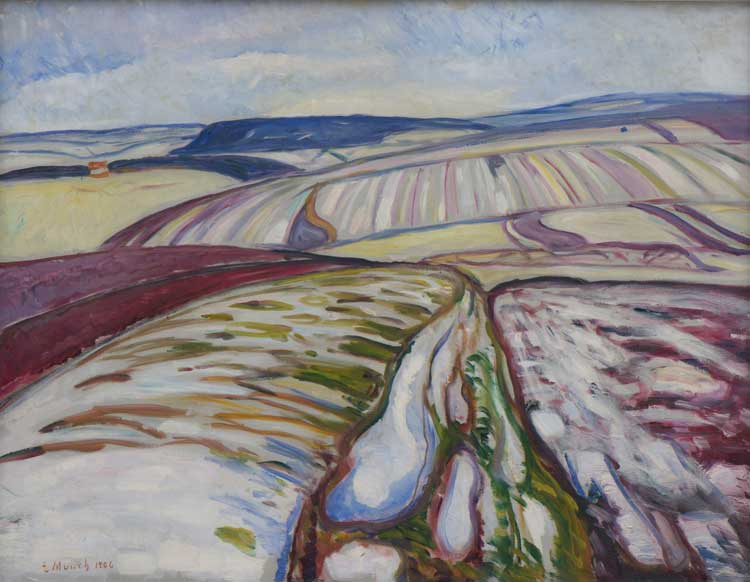
Edvard Munch, Snow Landscape in Thuringia, 1906. © Von der Heydt-Museum Wuppertal.
The most evocative pictures are brought together in the section Storm and Snow. The Storm (1893) shows, in purple-grey tones, rocks, fields and a windswept tree. It is dusk. Towards the front is a bundle of female figures with one coming towards the viewer, hands by her face as in Munch’s The Scream. In the background is a house with brightly lit windows. The promising comfort of the house makes the hostility of the outdoors even more keenly felt.
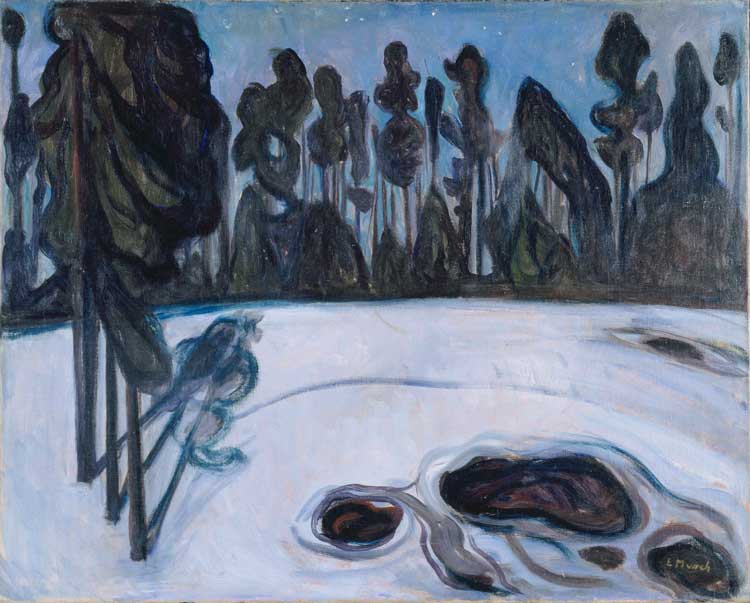
Edvard Munch, Starry Night, 1900-01. © Museum Folkwang, Essen.
A completely different atmosphere derives from Snow Landscape in Thuringia (1906). It is daytime and peaceful. There are fields, where the melting snow gives way to patches of earthy green and brown. The clouds, a light grey, are not too heavy and a gentle yellow glow on the horizon alludes to February when warmer and brighter days are in sight. In between, perhaps a November-storm and the increasing daylight in February, lies the dormant landscape of dark winter nights as pictured in Starry Night (1900-01) – produced two decades before the one shown at the Berlinische Galerie, which bears the same title.
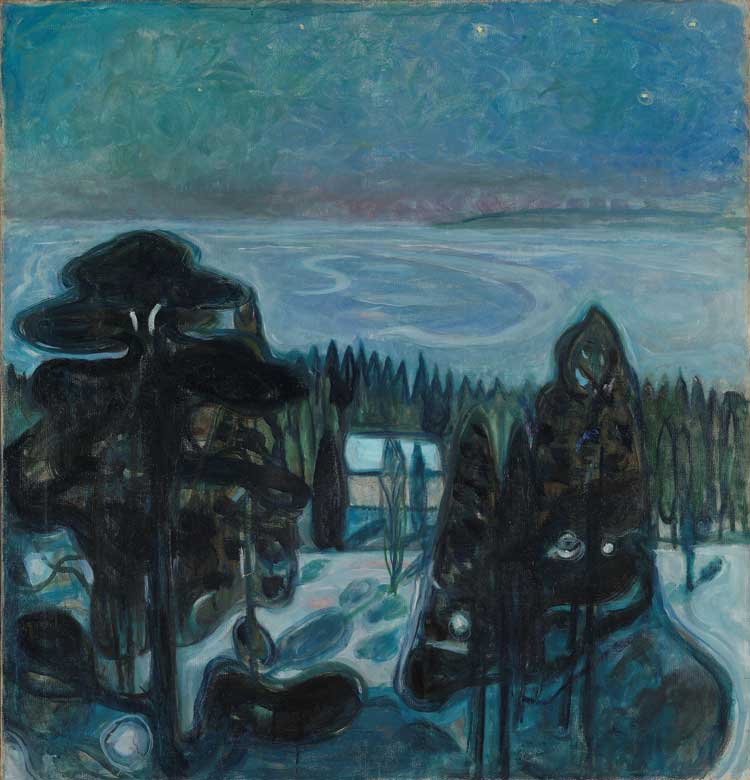
Edvard Munch, White Night, 1900-01. Nasjonalmuseet for Art, Architecture and Design. Photo: Børre Høstland.
It is kept simple: mainly snow in the foreground and, in the background, the black silhouettes of trees against a dark blue sky. A more magical view is presented in White Night (1900-01), where besides snow and trees, there is a small white house. In the background is a vast area that could be a frozen sea. Shades of light blue and soft pink in curvy lines suggest movement like snow gently twirling in the wind. The sky is a turquoise-blue with minute white specs that hint at stars.
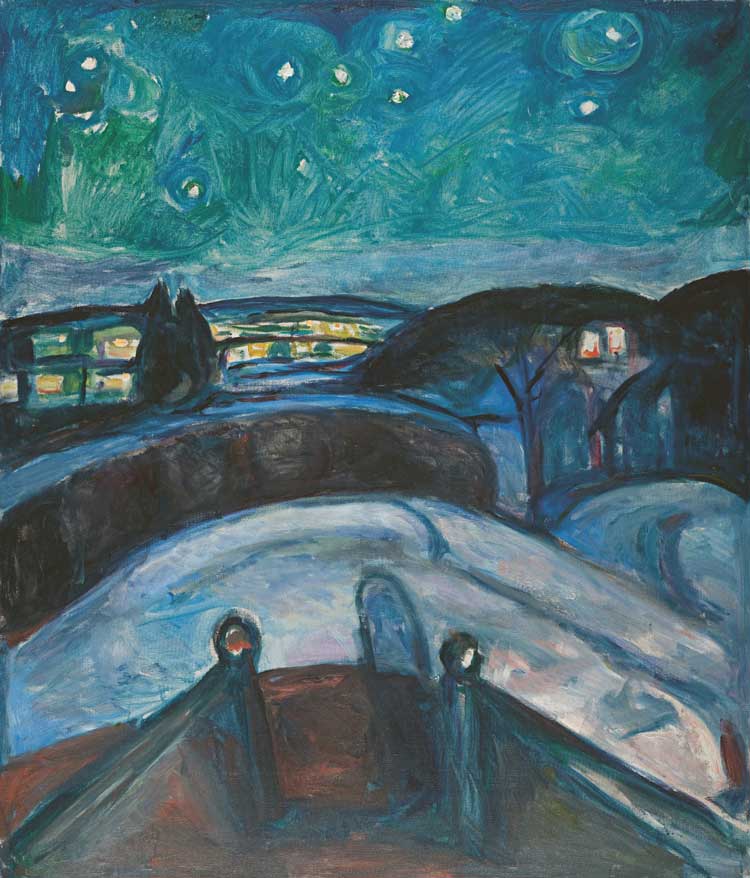
Edvard Munch, Starry Night, 1922–24. Photo © Munch, Oslo / Juri Kobayashi.
Another painting called Starry Night (1922-24), a version of the one hanging at the Berlinische Galerie, not only shows bigger stars compared to White Night, but also a small stretch of yellow in the distance signifying a city. Presenting these three images next to one another, traces the development from pure landscape to civilisation and brings out another central theme of Munch: metamorphosis and transformation. This is already reflected in the Frieze of Life at the Berlinische Galerie.
While in Kragerø, Munch worked on another frieze, this time for the ceremonial hall (Aula) at the University of Oslo. He was keen to get the commission and its imagery draws on the sciences such as chemistry and physics. The pieces are large and when they come to Potsdam, it will be the first time they have travelled outside Norway.
Altogether, Munch’s views of nature, particularly the ones without people, are less gloomy and troubled than the ones depicting human relationships. Ironically, seeing all these scenes of nature transporting the viewer to places reminiscent of the north, it feels as if the titles of the Munch exhibitions should be swapped to reflect their contents more appropriately. The Magic of the North is felt much more in the exhibition that will be shown at the Museum Barberini than in the one at the Berlinische Galerie. Similarly the idea of a Trembling Earth used at the Museum Barberini for its exhibition describes much better what is covered at the Berlinische Galerie: the scandal that shook Berlin’s arts world like an earthquake because of Munch’s trail-blazing style; the new artistic impulses such as print, which Munch took on; and, of course, the emotional stirrings that led him to continuously grapple with human relations on canvas.
Having two Munch exhibitions in close proximity is unusual and it is fortunate that they have different approaches. Trembling Earth has been much longer in the planning considering it is conceived for three venues across three countries with an international audience in mind and a universal subject at its core. The Magic of the North, in contrast, brings Berlin’s local perspective on Munch.
Both exhibitions were made in cooperation with the Munchmuseet in Oslo, which is the main lender of the works. After Edvard Munch: Trembling Earth closes at the Museum Barberini, the pieces on loan will return home to Oslo and the exhibition will be mounted again at the Munchmuseet from 27 April 2024.